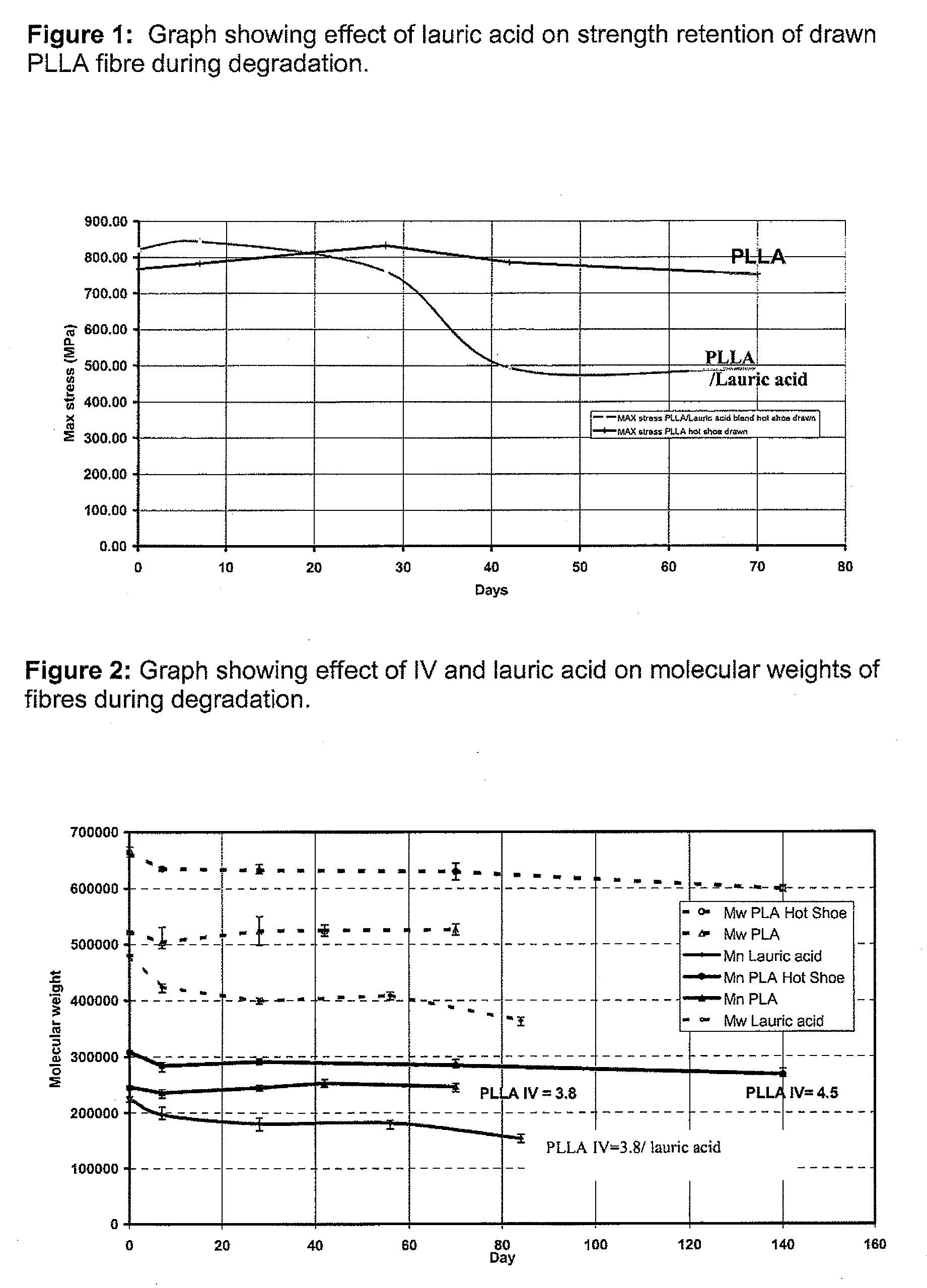High Strength Devices and Composites
a high-strength, composite technology, applied in the direction of surface layering apparatus, applications, domestic articles, etc., can solve the problems of not being strong or stiff enough, not being able to meet the requirements of high-load bearing applications, and the plasticiser being injected into high-strength fibres is expected to reduce both the strength and modulus of drawn fibres
- Summary
- Abstract
- Description
- Claims
- Application Information
AI Technical Summary
Benefits of technology
Problems solved by technology
Method used
Image
Examples
example 2
Fibre Production
[0058]The following methodology was used to produce both P(L)LA and P(L)LA / LA fibres
Method
[0059]The polymer (P(L)LA-IV=3.8 / Purac) or polymer blend (P(L)LA-IV 3.8 / Purac / lauric acid) was extruded using a Rondol 12 mm extruder. The extruder was fitted with a general-purpose 12 mm screw with a 25:1 L / D ratio. The extruder was fitted with a 2 mm (diameter) die (coated) with a L / D ratio of 6:1. The fibre was produced using a flat temperature profile of 240° C. for all zones. A nominal 0.5 mm diameter fibre was produced (using maximum screw speed of 50 rpm) and hauled off at a rate of 16 meters per minute. The diameter of the fibre was monitored during the run using a Mitutoyo laser micrometer. The extruded fibre was sealed in a foil pouch containing a desiccant sachet and then stored in a freezer at −20° C. prior to further processing.
example 3
Drawn Fibre
[0060]The following methodologies were used to draw both P(L)LA and P(L)LA / LA fibres
Method 1: Hot shoe
[0061]Fibre drawing was carried out using a customised drawing rig. The rig consists of two sets of godets and heated plate (hot shoe). The godets were preset to rotate at different speeds. The fibre was feed from a spindle, through the 1st set of godets, drawn over the hot shoe and around the 2nd set of godets. The drawn fibre was finally collected on a Leesona fibre winder.
Results
[0062]The fibres were drawn under various temperatures and speeds to produced fibres with different properties as shown in Table 1.
TABLE 1Temp 1stSpeed ofSpeed ofTemp 2ndSpeed ofSpeed ofFibreMaxpassGodet 1Godet 2passGodet 1Godet 2DiaTotalstressModulus(C.)(RPM)(RPM)(C.)(RPM)(RPM)(mm)draw(MPa)(GPa)(a) PLLA / LA160337———0.138209.0529.89.5150342———0.127248.0689.610.916041618010270.099405.0823.08.4(b) PLLA160324———0.13621673811.6180334———0.145190.271410.5716041618010180.178126.2759.08.7
[0063]These dra...
example 4
Lauric Acid Determination
Method
[0067]Approx. 0.1 g of each PLA / LA sample was dissolved in approx. 10 ml chloroform. Internal standard was added via glass pipette (0.9 mg / ml Hexanoic acid in acetone). Samples were left overnight to dissolve. 20-30 ml of diethyl ether was added to precipitate the polymer. An aliquot of each solution was filtered through 0.45 μm PTFE GDX Whatman syringe filters into injection vials. The analysis was carried out using Gas Chromatography under the following conditions:—
GC System:3Column:Phenomenex ZB-FFAP (30 m × 0.53 mm × 1 μm)Head pressure:6psiCarrier gas:HeliumSplit gas flow:15ml / minHydrogen gas flow:45ml / minNitrogen gas flow:20ml / minOven Program:Initial temp:200° C.Initial time:2minRate of ramp:5°C. / minFinal temp:240°C.Total Run Time:10minInjector temp:250°C.Injection volume:1μlDetector temp:250°C.Detection:FID
Results
[0068]Table 3 shows the amount of lauric acid contained in each P(L)LA / LA fibre.
TABLE 3AmountMeanSample Details(% w / w)(% w / w)PLA (3.8 I...
PUM
| Property | Measurement | Unit |
|---|---|---|
| Mn | aaaaa | aaaaa |
| Mn | aaaaa | aaaaa |
| tensile strength | aaaaa | aaaaa |
Abstract
Description
Claims
Application Information
 Login to View More
Login to View More - R&D
- Intellectual Property
- Life Sciences
- Materials
- Tech Scout
- Unparalleled Data Quality
- Higher Quality Content
- 60% Fewer Hallucinations
Browse by: Latest US Patents, China's latest patents, Technical Efficacy Thesaurus, Application Domain, Technology Topic, Popular Technical Reports.
© 2025 PatSnap. All rights reserved.Legal|Privacy policy|Modern Slavery Act Transparency Statement|Sitemap|About US| Contact US: help@patsnap.com


